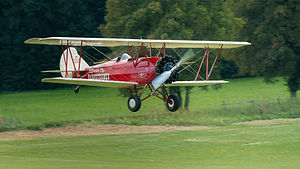Travel Air 2000
| 2000, 3000, 4000, CW-14, Sportsman, Osprey | |
|---|---|
 |
|
| Travel Air 4000, at landing | |
| Role | biplane aircraft |
| Manufacturer | Travel Air, Curtiss-Wright |
| Designer | Lloyd Stearman |
| First flight | 13 March 1925 |
| Introduction | 1925 |
| Primary user | private owners, aerial sightseeing businesses |
| Produced | 1925–1930 |
| Number built | approx 1,300 |
The Travel Air 2000/3000/4000 (originally, the Model A, Model B and Model BH and later marketed as a Curtiss-Wright product under the names CW-14, Speedwing, Sportsman and Osprey), were open-cockpit biplane aircraft produced in the United States in the late 1920s by the Travel Air Manufacturing Company. During the period from 1924-1929, Travel Air produced more aircraft than any other American manufacturer, including over 1,000 biplanes (some estimates range from 1,200 to nearly 2,000).
The original Travel Air Model A was engineered chiefly by Lloyd Stearman—with input from Travel Air co-founders Walter Beech, Clyde Cessna, and Bill Snook—largely as a metal-framed improvement of his immediately previous design of the wood-framed, metal-cowled Swallow New Swallow biplane, with elements of the best fighter aircraft of World War I, the metal-framed German Fokker D-VII. Most subsequent Travel Air biplanes were derived, directly or indirectly, from the original Model A.
The types shared a common structure of a conventional single-bay biplane with staggered wings braced by N-struts. The fuselage was of fabric-covered steel tube and included two open cockpits in tandem, the forward of which could carry two passengers side-by-side.
In common with the Fokker D-VII, the rudder and ailerons of first Travel Air biplanes had an overhanging "horn" to partially aerodynamically counter-balance the aerodynamic resistance of the controls when deflected, to provide a lighter control feel, and a more responsive aircraft. This gave Travel Airs their distinctive "elephant ear" vertical tails, and the similarly counter-balanced ailerons were also referred to as "elephant ear" ailerons—leading to the airplane's popular nicknames "Old Elephant Ears" and "Wichita Fokker." Some subsequent models were offered without the counterbalance, provding a cleaner, more conventional appearance and less drag. Elevator forces were trimmed out by use of an inflight-adjustable horizontal stabilizer.
...
Wikipedia
